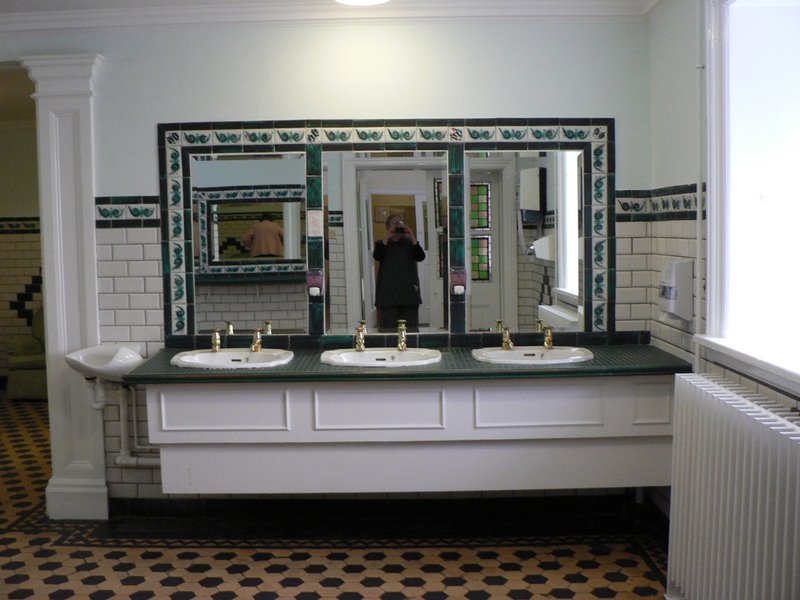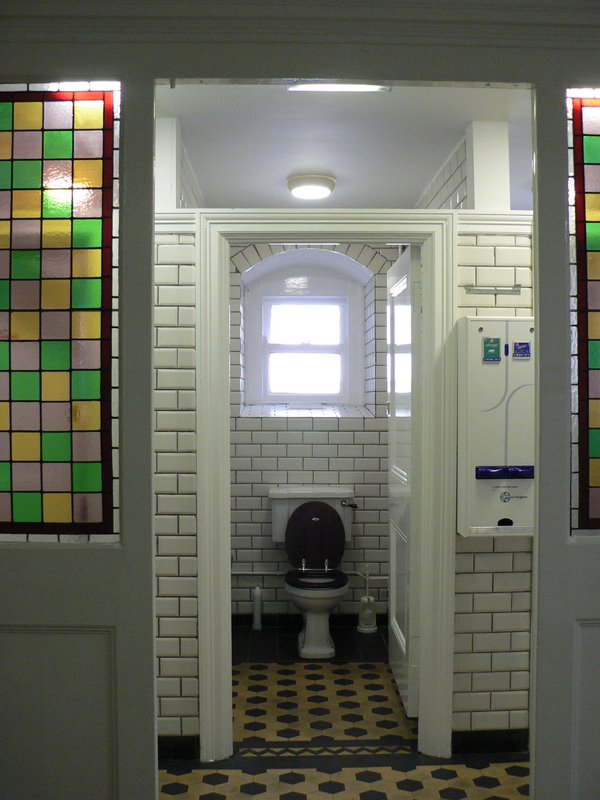34 Upper Fitzwilliam Street
Geo Wm FitzGerald family res 1837-1865
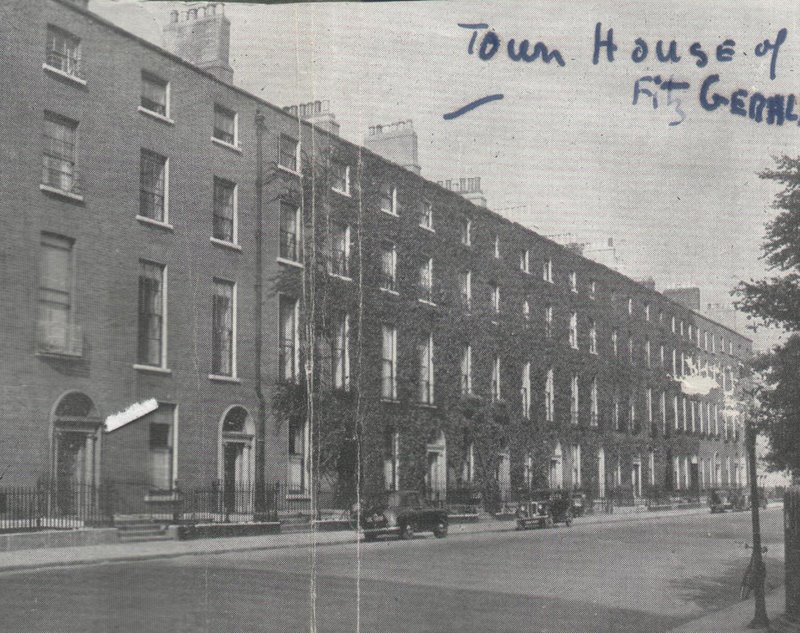
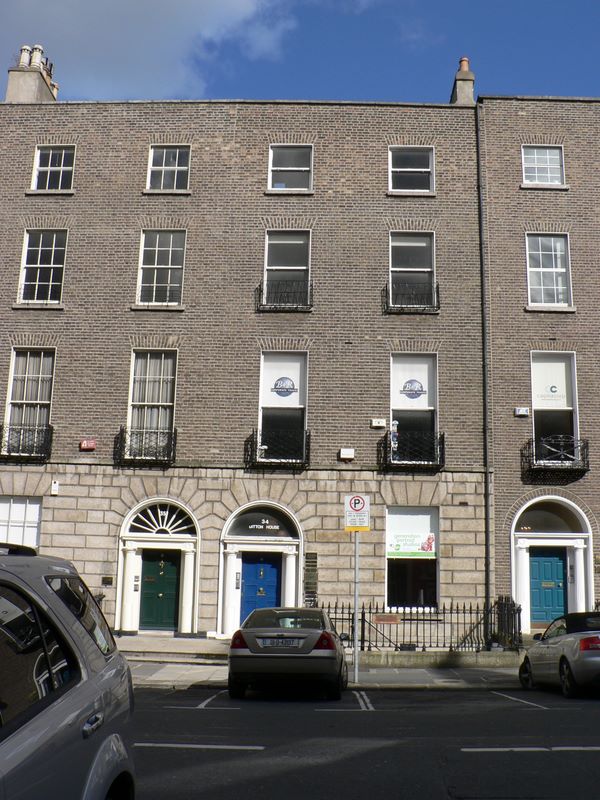
The black and white photo of Upper Fitzwilliam Street is copied from Granny's scrapbook. Right is a photo of the same address taken sometime around 2005, so there's probably at least fifty years between the taking of the the photos.
From 1837 until 1865 the Dublin directories list George William FitzGerald as resident at 34 Upper Fitzwilliam Street.
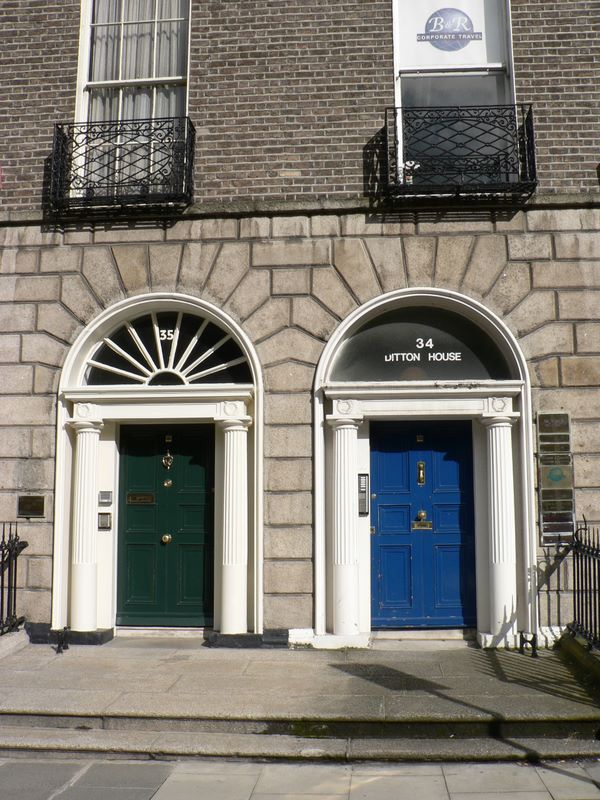
It's the one with the blue door
and the replacement windows.
At the time they moved in these houses would have been new. You can go on a brilliant tour of a similar one which is open to the public just round the corner.
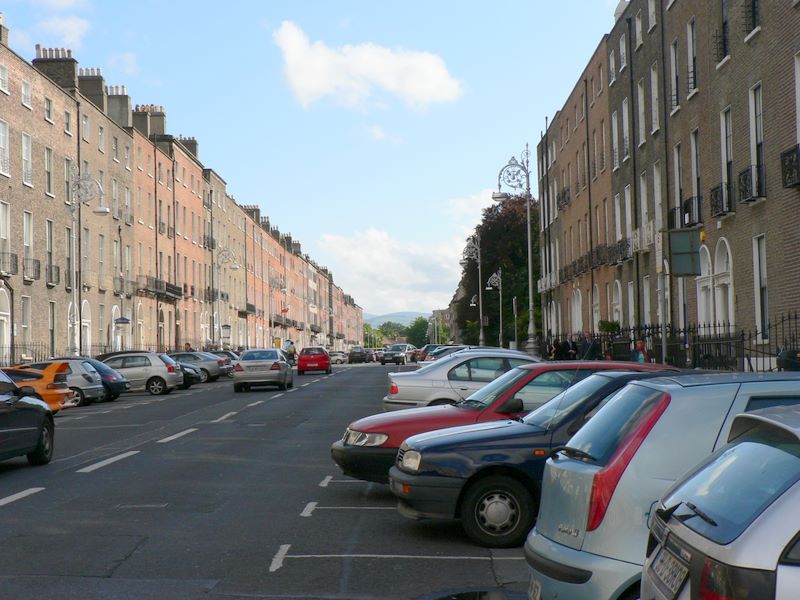
Upper Fitzwilliam Street, looking towards Fitzwilliam Square - the trees just visible on the right of the photo.
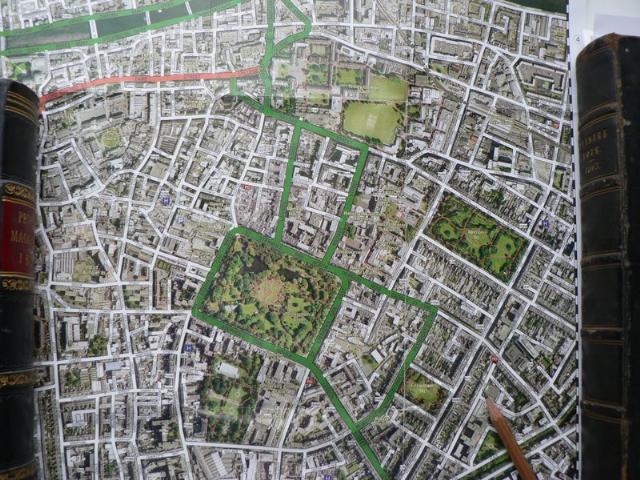
This is a map of Dublin with my pencil pointing to the exact location of the house. Fitzwilliam Square is the small green square just nearby.
Elm Park
Geo Wm FitzGerald family res 1867-1870
I don't have a photo of Elm Park, Merrion. I did glimpse it from the train on my way back to Dublin City from Dalkey, but I ran out of time and energy that day to do the walk.
George William (1810-1891) and several members of his family appear there in Dublin directories and other documents between 1867 and 1870 inclusive.
It's a golf course now I think.
4 Henrietta Place, Dalkey
Geo Wm FitzGerald family res c1865-c1896
Many family members lived here from 1865 at least until after the deaths of both George William (1810-1891) and Marcella (died 1896). Emmeline (Quick) Costello is known to have stayed here as well, around 1878 when she was eighteen.
By the time of the 1901 census there are no family members listed at No.4 but Joseph and his wife Evelyn and their babies Otho and Robert are at No.3.
We had great difficulty finding the two houses, but I found the place on a map drawn in 1865 - a massive map on the wall at the information centre in Dalkey. Henrietta Terrace would then have been quite new - a little row of four handsome houses up in the top north-east corner of the Dalkey map - just off the Harbour Road - with the sea at the ends of their long back gardens and the little harbour just a little above their northern side. We did in the end find the two houses but they are set well back - and up a hill - and are hard to spot.
If you can see the tiny print saying "Harbour Road" on the map below, look just above the "A D" of "Road" - just a tiny bit above the centre of the picture - and there it is, Henrietta Place - or Terrace - the two terms seem to have been used interchangeably.
Dalkey became a very fashionable place to live once the railway was in place to allow easy commuting in and out of Dublin City.
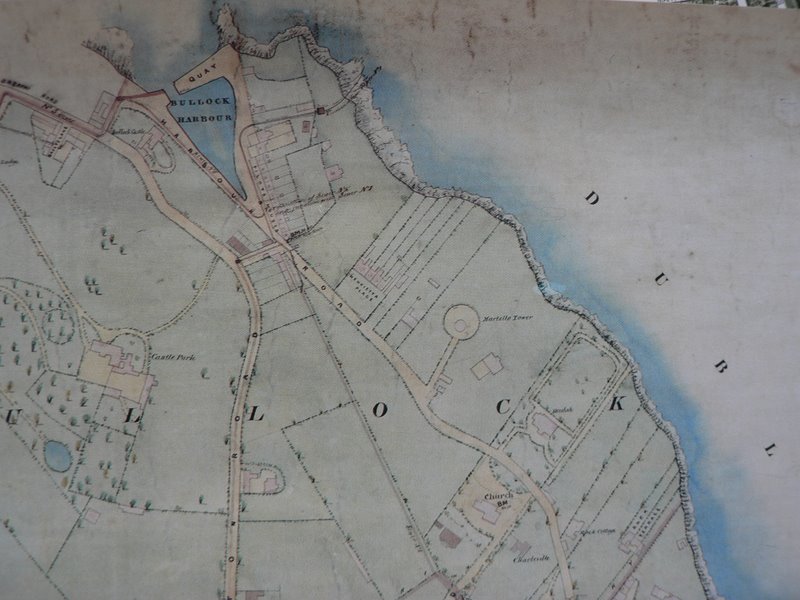
Other addresses
88 Upper Dorset St
- Edward FitzGerald (1858-1834) is listed as residing here in 1826 and he died there in 1834 (ref Dublin directories and we also have a copy of his lease)
- Edward + George Fitzgerald are listed as res here 1834-1836 (after death of Edward the engraver and before moving to 34 Upper Fitzwilliam Street)
Brooklawn, Merrion Avenue
- Edward FG also listed as res here 1835 (as well as 88 Upper Dorset St)
25 Stafford St
1 Gt George St South
30 St Anne St North
- Charles, Edward and George respectively listed in 1834
54 Mount St Upper
- Geo Wm FitzGerald listed as res here 1872 (between Elm Park and Henrietta Place)
205 Brunswick st great
- George Junior business listed here 1866 when Wine merchant, foreign agent
179 Brunswick st great
- George Junior business listed here 1868, 69, 70 when wine merchant, agent for IND Coope & co brewers, and Consul for rep. of Costa Rica
- Also James FitzGerald 1869(CHECK THIS)
- Also William AB in 1870 (listed as Barrister)
The Seasons, Ballymore Eustace
- Edward Foster FitzGerald res here from 1865 (age 27) till his death in 1878. I guess they must have owned rather than leased this property as in 1872 he is made a JP - I think the requirement for this was being a land-owner.
St Stephens Green Club
Albert House, Dalkey
15 Lower Prince Edward Terrace, Blackrock
5 Upper Prince Edward Terrace, Blackrock
Moone Abbey
St Andrews Church
The marriage of George William Fitzgerald to Marcella Dowdall on 19 Dec 1837 appears in the parish registers of St Andrews RC Church, Westland Row, a short distance from Fitzwilliam Street.
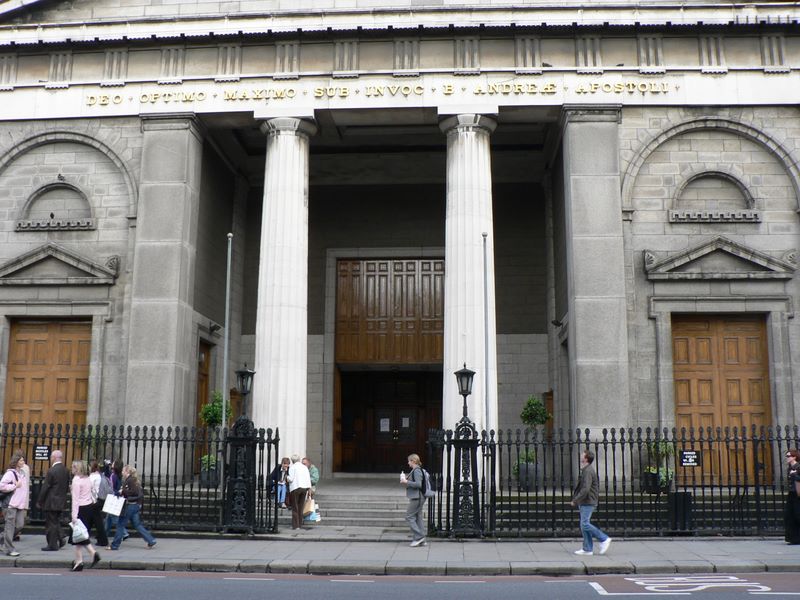
Actually the bride's name is entered as Matilda, but the marriage announcement in Freeman's Journal of 21 Dec 1837 is quite clear :
"On the 19th instant, George Willaim Fitzgerald, Esq. of Upper Fitzwilliam-street to Marcella, only daughter of the late William Dowdall, Esq., of the county Roscommon." (FJ 21.12.1837)
The Parish Register has Edward and Mary Fitzgerald entered as sponsors at the wedding.
At least nine of their subsequent eleven children were baptised there, and the records of the marriages of sons James and George are also in the parish register.
The remains of eight members of the family - including George William and Marcella - are also in the vaults here, having been moved from the church of Saints Michael and John when that church was decomissioned a few years ago. (For details see the section on Saints Michael and John church below.)
There's a nice picture of the inside of the church on St Andrew's own website : http://westlandrow.dublindiocese.ie/
Inside the church you can buy a lovely book full of photos and with an excellent history of the parish. Here's an extract:
"St Andrew's was the first Catholic Church to be built on a main thoroughfare. Though the Emancipation Law was in operation the government still refused to allow Catholic churches to be located on a main thoroughfares [sic] or in prominent locations. The fact the St Andrew's Church was built on a main thoroughfare and in a very prominent and fashionable area was a powerful political and religious statement and achievement. It is therefore not surprising that we find the Emancipator himself, Daniel O'Connell, driving forward the move of St Andrew's from Townsend St., and securing the site in Westland Row. However, there is one account that says that the plans were deliberately presented to the government showing the main entrace of the church to be in Cumberland Street and the back entrance on Westland Row and once the plans were sanctioned the entrances were switched." (Watson, Elizabeth, "An Enduring Presence : St Andrew's Church, Westland Row, Dublin", P22, May 2007)
Ms Watson also says elsewhere on the same page that on the 2nd January 1834 St Andrew's Church was blessed and opened for worship though it was still incomplete. So I guess it would have been quite exciting to be married in it at that time.
Church of Saints Michael and John
Lower Exchange Street, City of Dublin - just across the road from the River Liffey.
Eight Fitzgeralds were buried in the vaults here: Edward (1758-1834) and his two sons Edward (1796-1867) and George William (1810-1891); also George William's wife Marcella and four of their children, Edward, William, Charles and Henry.
All their remains were removed and sent to the vaults at St Andrews when Ss Michael and John's was decommissioned some years ago. I found this out just by just hanging around the place and chatting with people. I contacted St Andrews afterwards and they sent me the list of Fizgeralds that were sent to them from there. They are all proven to be ours.
At the time the building was in the process of becoming Smock Alley Theatre (see below)- after the ancient alley that used to be there before the church was built. On a lot of maps it's marked as the "Viking Centre" which it became for a while after being decommissioned.
Turns out now the church was actually developed from the remains of the old theatre!
Smock Alley Theatre
Conversion of the church of Saints Michael & John where the Fitzgerald family vault used to be before being transferred to St Andrews Westland Row. Read the fascinating history of the theatre - which goes back to the 1600s - by going to their website, clicking on the red bars then scrolling down to "About Us". It's absolutely central to the history of both Dublin and European theatre. And go see a play there. Well worth a visit.
PS when I first went to find it - having a couple of hours to wait before a train (see the story in my Introduction) - it was pretty well a building site as it was just then being refurbished. I was told it was thought that there had been a theatre on that site before it was a church but think that all the facts that are known about it now were discovered by intensive research while the refurbishment was going on.
The National Library
(NB Microfilmed RC parish registers are now available online - but weren't when I was searching - so I have left the comments made below as they were the conditions under which I was working. MM 10.05.2010)
I consulted the microfilm of the Parish Registers held at the National Library in Dublin. The ownership of the images remains with the church, and one is allowed only to take pencil notes in the Reading Room - written permission from the church must be obtained if before a copy can be taken.
The time I spend in Dublin is always so short that it has taken a few trips for me to feel that I'm coming close to understanding these registers. It looks as if through the ages, when a register began to fade or deteriorate in such a way as to make it hard to read, a new hand-written copy was made. I found on the same reel for example two seperate hand-written versions of the records in which I was searching. It's really nice that both versions were filmed, because there are human errors - several places in which the information given in one version is a significant little bit different from the other. The "Matilda" instead of "Marcella" recorded above, for example, could have been a mistake in transferring the record of the marriage from one book to another.
And sometimes both versions are so faded and difficult to read that it's only by consulting the two you can make out the information at all.
I didn't always find more than one version - probably the limitations of my time there as much as anything.
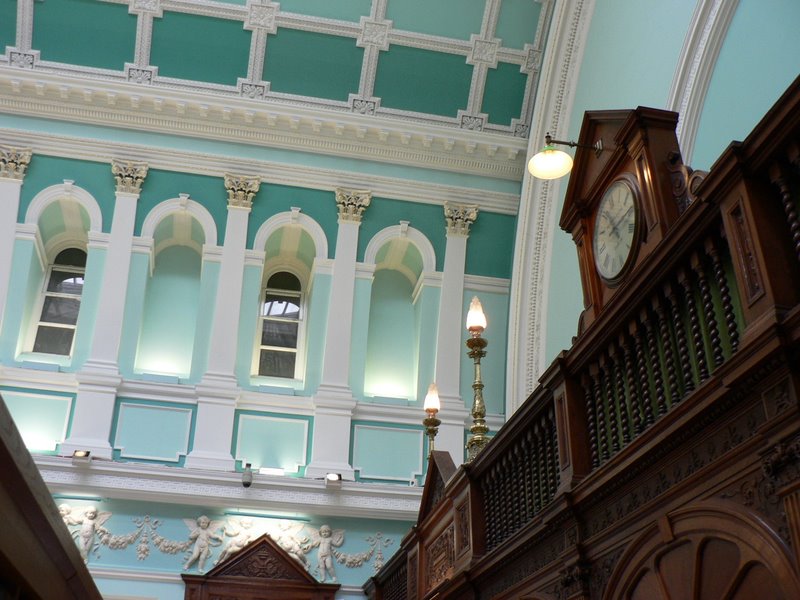
Besides St Andrew's Parish records, the National Library in Dublin holds what must be a complete or near complete run of Dublin Directories dating from the first published. The gaps in the years that I found could be because someone else was using the same books on the same day, but also sometimes you'll find that some books that have become fragile are not on the open shelves at all but you can still ask to consult them.
You're not permitted to photograph records either by the way, but I asked if I could just take a few of the building.
The National Library also has the most stunning women's room. Definitely wins my prize for outstanding washrooms of the world.
